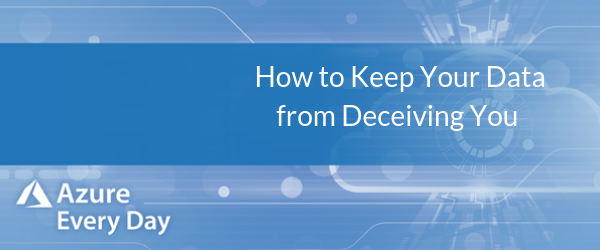
Just a note that our Azure Every Day posts this week will be stepping away from our normal posts as our regular bloggers are tied up with our Azure Data Week virtual conference all week. Hope you are registered and attending this great week of Azure sessions! Instead, we will be posting some Azure blogs written by some of our consultants and a couple old favorites. We’ll be back to our regularly scheduled program of new Azure content each weekday starting next Monday, Oct. 15th!
Here's a great one in case you missed it the first time about how to keep your data from deceiving you!
I know, you think you and your data are close and that it wouldn’t lie to you, right? Unfortunately, sometimes it happens and we don’t know every time. How can we keep that from happening? In this Azure Every Day installment, I want focus on how the cloud can help us to keep our data from doing that.
Here’s are some ways to avoid this problem:
1. We have to check our assumptions. Based on our calculations and how things look, we want to use tools like Power BI and keep our data accessible in the cloud for our organization. The more people that use that data, the more people are going to find challenges and problems with it.
2. We want to give our data more context. Oftentimes, this means combining our data with other data throughout our business. If we just look at marketing data separately from sales data, for example, we can make assumptions that aren’t there. You want to get rid of biases and require everyone to communicate about their data. By using tools like Azure Storage or Azure Spark to combine that data, you allow the business to analyze their data more effectively.
3. Lastly, we want to give the business their data back. By putting data into the cloud and making it available through Power BI, HD Insight or tools that connect directly to Azure Storage, we give that data the context and remove the biases that I talked about in #2. We can use things like Azure Data Warehouse, Azure DB or Cosmos DB to get our data to talk to each other. Once our data is in the cloud, we can get it to collaborate and integrate more effectively, which helps our organization to do the same.
It's very hard to make this all happen in a traditional on-premise environment and therefore our data deceives us. Once we bring our data to the cloud and take advantage of all the services there, everything gets a lot more accessible.
If you’d like help making your data more reliable and your organization more data centric, we are the people to talk to. Click the link below to discuss how we can get you there—we’d love to help.


-1.png)
Leave a comment